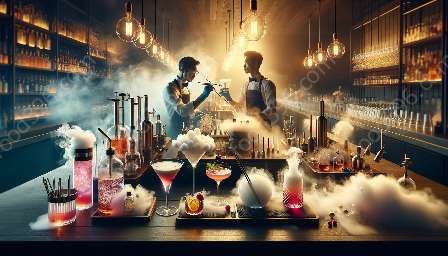Molecular mixology is a cutting-edge approach to cocktail creation that incorporates scientific principles and innovative techniques to elevate the drinking experience. In this article, we will delve into the world of molecular mixology and explore how professional bartenders utilize this technique to craft one-of-a-kind cocktails that push the boundaries of traditional mixology.
Understanding Molecular Mixology
Traditional mixology involves the art of mixing and blending various spirits, mixers, and other ingredients to create classic cocktails. Molecular mixology takes this art to the next level by incorporating scientific methods and modern technology to deconstruct and reconstruct flavors, textures, and presentations.
At the core of molecular mixology is the use of techniques such as spherification, foaming, emulsification, and gelification. These techniques allow bartenders to create unique spheres, airy foams, stable emulsions, and jellified textures that add a new dimension to cocktail presentations.
Cocktail Innovation through Molecular Mixology
Professional bartenders are constantly seeking to innovate and differentiate themselves in the competitive market. Molecular mixology provides them with a creative platform to experiment with unconventional ingredients, textures, and presentations, resulting in cocktails that are not only visually stunning but also offer an exciting sensory experience.
One of the key aspects of cocktail innovation through molecular mixology is the use of unusual ingredients and flavor combinations. Bartenders experiment with infusions, tinctures, and extracts to create unique flavor profiles that defy the norms of traditional mixology. For example, using techniques such as fat-washing, bartenders can infuse spirits with the essence of bacon, truffle, or even exotic spices, creating a new world of flavors for their cocktails.
The Role of Science in Professional Bartending
Molecular mixology blurs the lines between art and science in the realm of professional bartending. Bartenders not only need to have a keen sense of flavor balance and presentation but also a solid understanding of scientific principles such as pH levels, emulsification, and molecular structures.
Modern bartenders are increasingly embracing scientific knowledge to manipulate ingredients, textures, and temperatures to create cocktails that are visually captivating and offer a multi-sensory experience. With the help of lab equipment such as sous vide machines, rotary evaporators, and liquid nitrogen, bartenders are able to push the boundaries of traditional mixology and present customers with drinks that are truly extraordinary.
Embracing Molecular Mixology in Professional Bartending
As the demand for unique and inventive cocktails continues to rise, professional bartenders are recognizing the importance of embracing molecular mixology to stay competitive in the industry. By honing their skills in spherification, foaming, and other molecular techniques, bartenders can set themselves apart and attract a loyal following of cocktail enthusiasts.
Furthermore, the use of molecular mixology allows bartenders to create customized and personalized cocktails for their patrons, adding a sense of exclusivity and luxury to the drinking experience. By offering bespoke cocktails that showcase innovative techniques and flavors, bartenders can establish themselves as trendsetters in the ever-evolving world of mixology.
Conclusion
Molecular mixology represents a fascinating intersection of science and art in the realm of cocktail innovation. Professional bartenders who embrace this approach are able to push the boundaries of traditional mixology and offer customers a truly immersive and unforgettable drinking experience. As molecular mixology continues to evolve, it is poised to revolutionize the landscape of cocktail creation, inspiring a new wave of creativity and innovation in the world of professional bartending.

